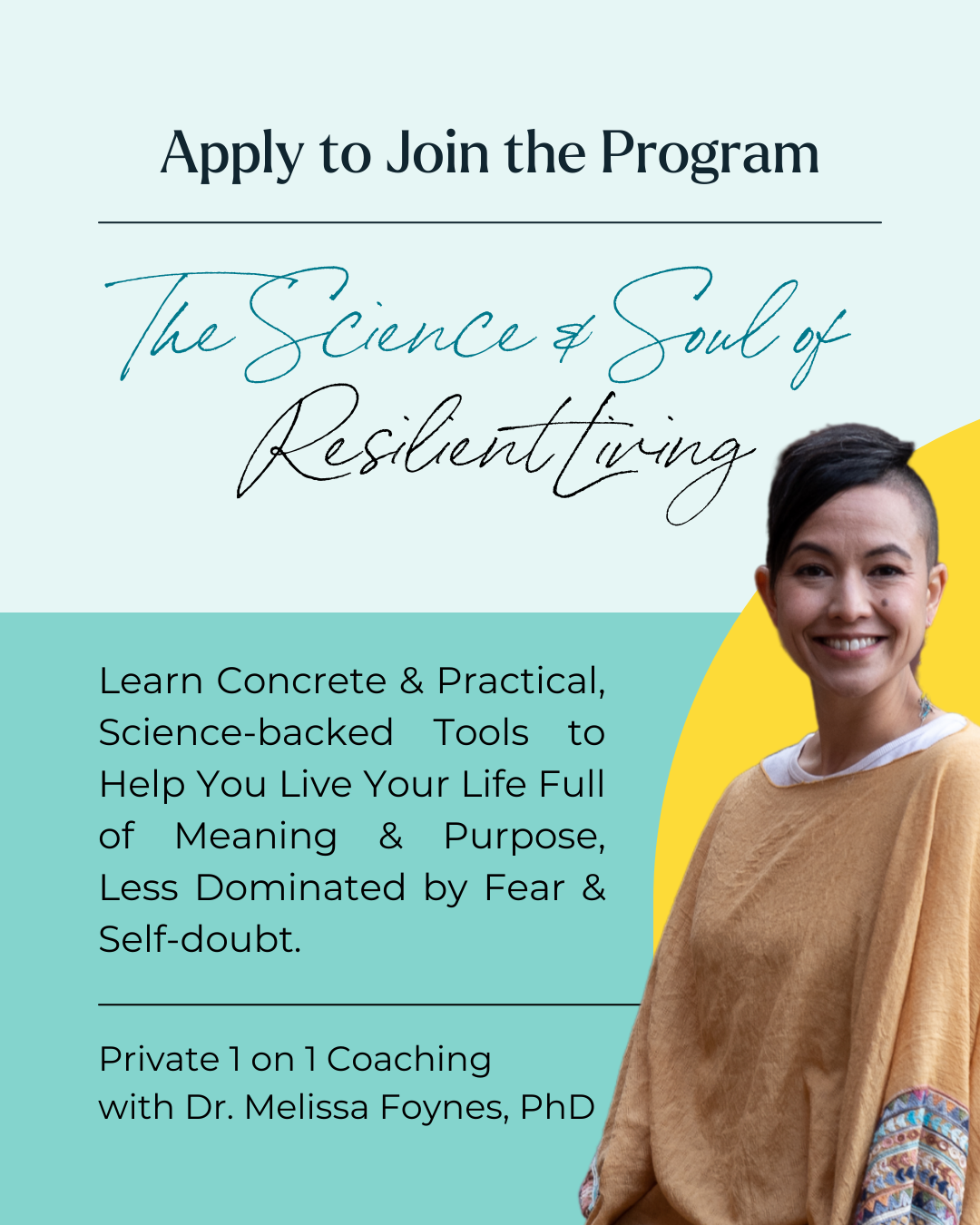welcome, I'm Melissa
Links
As a holistic coach, psychologist, mindfulness, meditation & yoga instructor, & Ayurvedic doula I offer personalized paths to growth & healing.
you may also like...
Toxic Relationships: 6 Key Responses
January 28, 2021
During this time — when we have a greater need for each other’s love and support — our relationships may be under unusual strain.
Even the most caring and attentive relationships can have toxic elements. Toxicity is defined as something that is harmful or harsh in a pervasive or insidious way.
Remember that our relationships are just as imperfect as we are, and we can even unknowingly cause harm and contribute to toxicity in them.
By learning to recognize and respond to the harmful patterns and dynamics of toxic relationships, we foster more loving and satisfying relationships.
Consider one or two relationships in your life that you’d like to nurture.
This relationship could be a romantic relationship, a parent-child dyad or a friendship. Or it may involve more than two people, such as a co-parenting situation with more than two parents.
The first step to changing harmful patterns is being able to recognize them when they occur.
Let’s dig a bit deeper into specific relationship patterns and communication styles before discussing strategies to address them.
4 Main Relationship Patterns
The four main relationship patterns include…
-
- Constructive engagement
- Mutual avoidance
- Destructive engagement
- Engage distance
While we can engage in these patterns at different points in time, there is usually one dynamic that dominates a relationship.
1. Constructive engagement involves both people being aware of their needs, desires and preferences — plus the ability to make requests and bring up concerning issues in a calm, clear and non-attacking manner.
It also involves approaching the other person with understanding and empathy despite a disagreement.
Ideally, this is a pattern that we would like to be in most of the time.
2. Mutual avoidance, also called withdraw-withdraw, involves infrequent arguing and minimal closeness.
This pattern may stem from difficulties trusting the other person to be supportive during times of vulnerability and can be reinforced by the relief experienced from not confronting troublesome issues.
With mutual avoidance, both people tend to avoid bringing up issues of concern.
3. Destructive engagement tends to include lots of hostile expressions.
When under attack, we tend to become defensive, which can interfere with our ability to understand the other person’s perspective.
Also called the attack-attack pattern, this dynamic can color future interactions, leaving us to expect mutual hostility before it begins.
4. Engage-distance is also referred to as a pursue-withdraw pattern.
Each person responds differently; for example, one person wants to address a problem while the other person doesn’t.
This dynamic may start as effective or constructive but end up destructive; the more the engager tries to engage, the more the distancer distances — and the cycle reinforces itself.
Communication Styles
In addition to these dynamics, there are communication styles that may occur within the context of relationship patterns.
Research from the Gottman Institute indicates the following communication styles are particularly important to highlight because they can predict the termination of relationships:
Criticism – containing an inherent judgment, this might look like “you’re so self-centered and distracted by your own work that you don’t think to ask me about how I am.”
Contempt – mocking, name-calling, eye-rolling, laughing, sarcasm or other unkind behaviors. The person who is being treated with contempt typically leaves the interaction feeling worthless.
Contempt is fueled by long-simmering negative thoughts about the partner and is the single greatest predictor of divorce.
Defensiveness – denying responsibility for our behavior through excuses or through attacking or blaming the other person.
Stonewalling – involving some kind of withdrawal from the interaction. The withdrawal could take the form of shutting down through silence or leaving the conversation by physically going elsewhere. It can also be a more active form of withdrawal, such as evasive responses or questions.
We need to tackle these head on if there is hope to maintain a long-term relationship.
Regardless of the specific relationship pattern or communication style, there are some core skills that can be beneficial.
Let’s explore six key strategies that can help us recognize, respond and heal toxic relationships.
Responding to Toxic Relationships:
Six Key Strategies
1. Observe and Describe Without Judgment
Learn to observe and describe your own emotions, physiological sensations and thought patterns without judgment, as well as the verbal and nonverbal expressions of others.
Putting those observations into words in a non-judgmental way means describing them as they are and without value judgments.
When we are able to observe and describe without judgment, we can feel more seen and heard, communicated more effectively, and navigate intense emotions better.
Even when we have judgmental thoughts, being able to take a step back and label them as judgmental can lead to more effective action.
For example, when you notice the thought, “My child is having a ridiculous tantrum right now” being able to say, “I’m having some judgment about what my child is doing.”
That doesn’t necessarily mean that you are okay with what is happening, but labeling the thought as a judgment might diffuse the emotion and allow you to be less reactive and proceed in a way that deescalates the conflict.

2. Establish Names for Relationship Patterns and Communication Styles
Create a shared language for describing relationship patterns and communication styles.
When we join in naming and addressing the dynamic, the problem then lies in the dynamic rather than one of us.
You can use the more clinical names if they resonate — or you can come up with your own. For example, destructive engagement could be called the “tornado.”
For clients with younger children, animal metaphors can be helpful. Saying something like “I’m feeling like a turtle now, what about you?” can be a shared way to voice mutual avoidance.
By non-judgmentally naming the dynamic outside of a heated conflict, you can talk through what doesn’t work about that pattern and what actions you’ll each commit to when it happens again in the future.

3. Commit to Behaviors That Interrupt Rather Than Promote These Patterns
Notice the harmful ways that you respond, and try to develop more constructive behaviors.
For example, if you tend to speak in an irritated tone, commit to pausing for at least five counts before responding in order to monitor your tone.
Or if you are tempted to withdraw, try saying “I’m noticing an urge to withdraw, can you help me stick with this conversation?”
If you notice a tendency to criticize, practice framing things as nonjudgmental descriptions, such as likes and dislikes, rather than criticisms.

4. Balance Holding Yourself Accountable With Holding the Other Person Accountable
Accountability is not always equally shared; sometimes an incident is largely due to one person’s actions.
Be mindful of ensuring the balance you are holding accurately reflects the reality of the situation.
Maintaining this kind of balance involves being aware of tendencies to over-apologize when it’s not necessary — as well as overly-blaming others. It also means offering a genuine apology when one is warranted.
Importantly, when relationship toxicity stems exclusively from someone else’s behavior, don’t over-assume responsibility for another’s actions.

5. Communicate Validation for Others and Ourselves
Validating involves communicating that the other person’s experience is understandable and makes sense.
This understanding can be based on the current situation, history of the relationship, past experiences or how other people might respond in similar circumstances.
With validation, it’s important to remember that you are not necessarily agreeing with their perspective — rather you are communicating that you understand why they might feel that way.
When we feel understood we can soften a bit, which allows us to regulate our emotions and engage more effectively.
Validation also applies to ourselves, so it’s important to take time to notice how your experience is understandable and makes sense, too.

6. Focus on Cultivating Positive Time Together and Enhancing Connection Outside of Conflict
Cultivate a reserve of positive connection to deepen intimacy and to help provide a resource to guide you through conflict when it occurs.
Try engaging in a shared activity or a conversation about a topic that you are both passionate about.
When apart, leave notes or text messages throughout the day.
These can serve as important ways to nourish your relationship so that it continues to grow.
Relationships are like gardens; they need sun, water and fertile soil. At times, we need to prune, trim, fertilize and find ways to battle pests that bring disease. As with gardening, acquiring new knowledge and developing different skills are often needed to foster healthy growth in our relationships.
Responding to Toxic Relationships: Next Steps
While it can be difficult to navigate these challenges, it’s possible to deepen intimacy, cultivate positive time together and achieve greater relationship satisfaction.
If you’re struggling with toxic relationships and would like to learn more…
- Listen to the full podcast episode
Skillfully Responding to Harmful Relationship Dynamics
You can also learn more about my coaching practice through this free video series:
The Science & Soul of Building Resilience
In this 4-part series you’ll learn:
- Body awareness to help us center ourselves and live in a present-focused and embodied way even in the midst of stress
- Decreasing our stress response so we can access intuition and connect to our needs
- Values clarification to guide decisions about prioritizing our time, attention and energy
- Self-compassion to soften our harsh inner critics and facilitate growth following mistakes
SIGN UP to Get Instant Access!
MAKE SURE TO SUBSCRIBE TO THE SCIENCE & SOUL OF LIVING WELL PODCAST!
Apple | Google | Spotify | iHeart | Audible
You can also contact me or join us on Instagram – @drfoynes.
Related Articles on Enhancing Confidence, Empowerment & Self-Worth:
How to Practice Self-Forgiveness: 4 Exercises
How to Deal with Envy: 8 Key Principles
What’s Wrong with Judging? Cultivating a Nonjudgmental Stance
Freebie Alert!
Freebie Alert!
Newsletter
Sign up to get a dose of love, inspiration, wisdom &
all the latest news on events straight to your inbox.
privacy
terms
made with ❤ by habitat society
Explore
©2022, Melissa foynes
Thank you
You're subscribed to my newsletter. Please whitelist my email to make sure you don't missing anything I send you.




